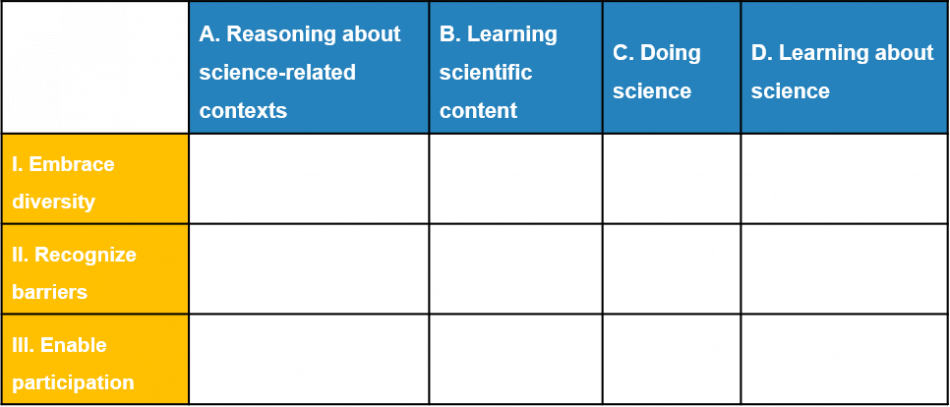Supporting materials
NinU grid lactase example (PDF)

The idea of ‘science for all’ can only be accomplished when we recognize the need to embrace diversity, reduce barriers, and enable participation in the science classroom.

Inclusive education is understood as educational settings where all students receive high-quality instruction in age-appropriate classes that enable them to succeed in the core curriculum. There are multiple frameworks for inclusive education. Universal instructional design (UID), universal design for instruction (UDI), and universal design for learning (UDL) are all educational frameworks based on applying the seven principles of universal design to learning environments.[1] The basic goal of all of these frameworks is to increase accessibility to learning for all students by accommodating the needs and abilities of all learners and eliminating hurdles in the learning process. While these particular frameworks have existed since the 1990s, recognition of the need to implement inclusive education practices dramatically increased with the passing of the UN Convention on the Rights of Persons with Disabilities (CRPD) in 2006. For specific ways of accommodating a particular student’s needs, teachers should acquaint themselves with their student’s individualized education program (IEP), particularly the section on accommodations/modifications and/or the 504 plan (or their country’s equivalent). For students without IEPs or 504 plans, Table 1 provides a general idea about possible accommodations to resolve barriers in the classroom. These accommodation ideas are grouped into four categories: presentation, response, setting, and timing and scheduling.
| Barrier | Accomodation | Examples for science classes |
|---|---|---|
| The way information is presented by the instructor (e.g. text, lecture, video, tactile) | Presentation accommodations • Change the way that instructions, directions, and information are presented | • Books and materials with large print • Text using plain or easy English • Supplement text with icons and/or images, e.g. in experiment protocols • Visual cues (e.g., colour-coded text) • Audiobooks • Closed-captioned videos • Use of text-to-speech function or handheld device • Use of tactile pictures or models (e.g. through 3D printing) |
| How the student is required to demonstrate knowledge or understanding (e.g. writing, speech, drawing, building) | Response accommodations • Allow students to complete assignments or assessments through ways other than typical verbal or written responses | • Speech-to-text software • Orally dictate responses (using a scribe or digital recorder) • Draw or build models or make a photo or video story instead of writing • Use prepared pictures or text clips and attach them to the correct position of a model • Show processes with the help of a step-by-step model |
| The characteristics of the setting (e.g. noise level, lighting, seat spacing and location) | Setting accommodations • Changes in the learning environment or in how the environment is structured | • Preferential seating (e.g. near the teacher, with an assisting co-learner, alone) • Testing in a separate location • Reducing stimuli in the room • Making experiments accessible (e.g. access to workbench, adaptation and supplementation of lab devices for easier handling) |
| The timing and scheduling of the instruction (e.g. time of day, length of time) | Timing and scheduling accommodations • Changes to when and how long students have to complete assignments, experiments, exams, etc. | • Extended time to complete tasks, such as experiments • Opportunity to take breaks as needed • Shorter or longer testing sessions |
The principles of making learning accessible to all students is particularly important in science education, as scientific literacy among the general public is a basis for evidence-based decision-making in democratic societies. For this purpose, the ‘NinU grid’ (original German name ‘NinU Raster’) was developed to support science teachers in the creation of inclusive science lesson plans.[2] The NinU grid is named after the Netzwerk inklusiver naturwissenschaftlicher Unterricht (Network for Inclusive Science Education) that developed the grid. The difference between the NinU grid and other frameworks or tools for inclusive education is that the NinU grid is specifically designed for inclusive science education. The NinU grid combines three main components of inclusive pedagogy (embracing diversity, recognizing barriers, and enabling participation) with four central objectives of science education (reasoning about science-related contexts, learning science content, doing science, and learning about science). The NinU grid presents a series of questions (see Attachment 1) to help guide a teacher in the preparation of a more-inclusive science lesson or adaption of an existing lesson plan. Our experience thus far, when presenting the NinU grid to in-service and pre-service teachers, is that questions arise on how to use it and where to begin. Here, we will give a brief overview of how to apply it by adapting a lesson plan for teaching sugars and enzymes based on the real-world context of lactose intolerance. The use of such a science-related context is central for the application of the NinU grid.

The basic advice given by the NinU network is to begin with the questions from the first column of the grid (science-related contexts) and then to complete one of the other three column: learning scientific content, doing science, or learning about science.

It is important to first identify the central objectives corresponding to the four columns in the grid. In the example lesson plan, the real-world context (column A) is lactose intolerance, the scientific content (column B) is sugars and enzyme function, the doing science aspect (column C) is making observations, conducting experimentation and making conclusions based on data. For this lesson plan, the learning about science aspect (column D) plays only a minor role, namely, understanding the implications of the results. To illustrate how different questions in the grid can be used to adapt a lesson plan, we have provided a specific grid for this lesson plan to make it easier to delineate what is focused upon (see Attachment 2).

We begin by going through column A, working from top to bottom. For example, we add a tactile representation option during the introduction of the real-world context to allow any visually impaired students to better participate in the activity. It is possible that not all questions will lead to inspiration for changes. Instead of writing out answers to each of the questions, we use them as a comb to go through the rest of the lesson plan, to identify areas for expansions or adaptations, and then make these changes directly to the lesson plan. We then continue this process with columns B, C, and D. Here, we make changes that focus on teaching new, relevant terminology for the activity, for example to students whose native language is not English. Attached are two lesson plans based on lactase: the original lesson plan (Attachment 3) and an adapted lesson plan based on the grid (Attachment 4), which outlines all of the adaptations in detail. The adaptations made using the grid in the second lesson plan are marked in green. Following each change is a code to the corresponding question, e.g. A-II-1 refers to column A, row II, question 1 (see Attachments 1 and 2).

While going through all of the questions takes a great deal of time, we found that some questions were more relevant and effective for our particular lesson plan than others. We have marked our specific NinU grid (Attachment 2) in green to highlight the frequency of use (darker green means more frequent use).
We also suggest that first-time users of the grid begin with a lesson plan or activity that they are very familiar with and ideally have already used. This will make it easier to go through the grid and identify the areas that can be adapted for a certain class.
For practitioners who are just beginning to use the grid or are very short on time, we believe that simply using the following questions can make a big difference:
Here, it is important that these questions are asked for each of the components of science learning (grid columns), as we have found that we had significantly different answers to our questions when thinking about ‘learning scientific content’ versus ‘doing science’, for example.
The lesson plan is based on Chemie in Kontext and contains all aspects of this type of lesson. We have only worked out the details for units one and two to show the adaptations, but it would be necessary to consider all four units to fulfil the principles of Chemie in Kontext.[3]
[1] Rose DH, Meyer A (2002) Teaching every student in the digital age: universal design for learning. Association for Supervision and Curriculum Development, Alexandria, VA. ISBN: 0-87120-599-8
[2] Stinken-Rösner L et al. (2020). Thinking inclusive science education from two perspectives: inclusive pedagogy and science education. RISTAL 3: 30–45. doi: 10.23770/rt1831
[3] Demuth R et al. (2008) Chemie im Kontext – Von der Innovation zur nachhaltigen Verbreitung eines Unterrichtskonzeptes. Waxmann, Münster. ISBN: 978-3-8309-1977-3
The article presents a useful and practical framework that science teachers can use to infuse diversity into their practical science lessons that is applied in German schools according to the methodology presented. It can be used as a starting point for conversations among teachers on the importance of diversity in science education teaching and learning as well as in teacher training with some adaptations to apply in other contexts.
Dr Vasiliki Kioupi, Lecturer in Science Education, UK